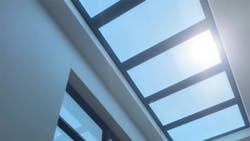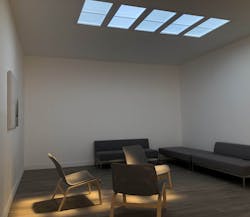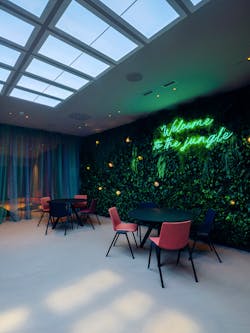First look at the Virtual Sun for enhanced interior illumination
In 2013, Jonathan Clark and Sean Flynn co-founded the U.S.- and U.K.-based Innerscene with the goal of developing wall-mountable 3D displays realistic enough to be substituted for physical windows. LED technology engineered into Innerscene’s Virtual Sun artificial skylight mimics the experience of real sunlight for spaces without views. Each rectangular unit weighs 82 pounds, measures 38.2 inches by 20.7 inches, and can be installed horizontally in a ceiling, placed vertically in a wall, or mounted into the corner of a wall and ceiling at an angle.
Virtual Sun casts electric light of varying color temperature onto objects and creates shadows; and when occupants look up, they appear to see the sun surrounded by a boundless blue sky. This illusion is achieved with a 2D image slice created by an array of collimated images and projected onto a Fresnel prism sheet, which produces an effect similar to virtual reality goggles or a 3D TV, but without the need for glasses.
As users move past or under Virtual Sun, the sun appears fixed in the sky. This effect is enhanced when multiple units are placed side-by-side: It doesn't appear that each window contains its own sun, but rather that all the windows are showing the same sun.
When circadian rhythm mode is engaged, the sun slowly dims as day transitions to night, and the quality and color temperature of the light automatically adjusts to match.
Each unit emits a diffuse light that illuminates the room, radiating 180 degrees, and a tight rectangular "sunbeam" with a 30-degree beam spread.
According to Innerscene CEO Jonathan Clark, Virtual Sun looks real because “[users] get all the depth cues satisfied: things like motion parallax — when you move your head left and right, things far away from you move slowly, and things close to you move quickly.”
Clark and his team didn’t necessarily have lighting in mind when they began developing prototypes. “We used the technique to make 3D displays where you could see anything you want,” Clark said. “Then we asked, ‘What is something that people would get value from — something that can be used all the time?’ and lighting popped into our minds.”
How real is it?
How does Virtual Sun compare to natural sunlight? According to Innerscene’s measurements, the UV light component is approximately 0.41µW/cm2 with 10,000 lux at the surface of the unit that falls off exponentially with distance, meaning the material degradation caused by UV rays — typically prevented by a film in windows and skylights — is essentially nonexistent. It is safe to use around sensitive art pieces like paintings, photographs, and sculptures, and it falls within the parameters of UV radiation suggested by The Conservation Center for Art & Historic Artifacts. However, the lack of UV emission also means that Virtual Sun does not promote vitamin D production — occupants will still need to step outside into real sunlight for that.
Beyond aesthetics, Virtual Sun can provide other benefits that come from skylights and access to the sun, such as circadian rhythm regulation, or entrainment. When the team tackled the challenge of matching the sun’s brightness, they started implementing the color changes used for the device’s circadian rhythm feature.
“We wanted to have a blue sky and the sun,” Clark said. “If you go out and measure the color temperature of the sky without the sun, it’s 40,000K on a clear blue day, but most LEDs don’t go over 6500K, which is like an overcast day if you had it in a panel format.”
The skylight developers needed to research how to combine LEDs of varying colors to produce the blue sky with a full-spectrum output.
“Once we combined multiple LEDs, it was easy to shift that point along the black body or daylight locus to get any color temperature we wanted,” Clark explained, noting how testers felt a difference under a daytime blue sky versus the warmer skies of later evening. “It’s amazing to feel what 20,000K or 40,000K feels like compared to, say, 6500K. It’s like you’ve had an extra cup of coffee that day — it really wakes you up.” Still, he noted, ”You don’t want that in the evening when you’re going to bed, so being able to then transition down to warm temperatures was just a natural outcome.”
Innerscene designed the circadian rhythm cycle mode to automatically vary the brightness and correlated color temperature (CCT) over the course of a day to mimic the lighting outside. Installers can also program the skylight with a current location so that sunrise and sunset changes coincide with real-time natural daylight. When operated in circadian rhythm mode, Virtual Sun’s warmest CCT measures 3000K and the coolest, 18,000K. With a reported color rendering index (CRI) value greater than 90, the unit can match the sky’s color with a high level of accuracy. Unless you notice that the shadows around you aren’t moving as the day goes on, you might just believe that you are experiencing the sun overhead. The current commercial version of Virtual Sun, model A7, launched in 2020. Innerscene distributes globally and can be contacted for pricing information.
This article has been updated since first publication.
"First look at the Virtual Sun for enhanced interior illumination" originally appeared on Architectural SSL, an Endeavor Business Media partner site.
HAYDEN BEESON is a writer and editor with over seven years of experience in a variety of industries. Prior to joining Endeavor Business Media as associate editor of Architectural SSL and LEDs Magazine, he was the managing editor of several machine reliability publications.
Follow our LinkedIn page for our latest news updates, contributed articles, and commentary, and our Facebook page for events announcements and more. You can also find us on Twitter.
Hayden Beeson
HAYDEN BEESON is a writer and editor with over seven years of experience in a variety of industries. Prior to joining Endeavor Business Media as associate editor of Architectural SSL and LEDs Magazine, he was the managing editor of several machine reliability publications.









